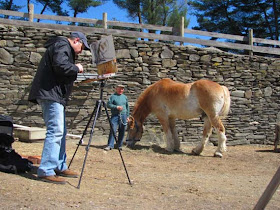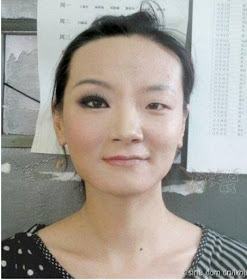My friend Christoph Heuer has shed some more light on the picture. He went through the catalogue of the Mythos Krupp exhibition and found the following chapter, which gives a detailed account of the context of the Kley painting. It turns out that it had a specific point as a propagandistic retaliation to an article in the London Illustrated News.

Here's the image which appeared in the London Illustrated News, with the subtitle "THE DEVIL'S FOUNDRY--FOR GERMANY'S GREAT GUNS: THE KRUPP WORKS AT ESSEN -- A PRESS-ROOM."
And here is Christoph's translation of the chapter in the exhibition book:
Myth of Steel
Since old ages iron and steel are surrounded with myths and a secret aura. The fact that it has a superiority over other materials is reflected by the high position a blacksmith had in early societies: they possessed special rights as they were able to master forces of nature like fire and with this tamed power be able to produce weapons, that promised and represented power. Even after the age of reason they were still surrounded by this aura well into the twentieth century.
In art, this is well reflected in the paintings of Heinrich Kley's "the Devil of Krupp" from 1914 and Otto Bollhagen's "crucible steel casting in the old melting building" from 1912. Red glowing, gleaming colors illuminate the dark scene with a ghostly light and reflect an association of hellfire. At the same time, these paintings also display the pride in mastering the forces of nature by man and industry...
...The building for melting iron was the centre of the Krupp crucible steel production. In Kley's painting, between the workers, the giant devils supply themselves with liquid glowing steel as if having a drinking party. The scene is dominated by red glowing crucibles and appears in a ghostly light. The painting is the best known commissioned work of Kley for the Krupp company. It hung in the casino (a restaurant within the factory canteen) in Duisburg-Rheinhausen.
It was made as a reaction to the anti-German propaganda in the British press. Shortly after the outbreak of WW I The "London Illustrated News" had published a Bollhagen painting under the title "the Devils Foundry: for Germany's great Guns: the Krupp Works at Essen". Kley accordingly displayed the devils with artistic exaggeration.
Kley also worked for the magazines "Simplicissimus" and "Jugend" who also reproduced the "Devils of Krupp."....Bollhagen captured the workforce intensive crucible steel casting. Under a ceiling illuminated by a red firelight and in front of the white glowing ovens workers draw the crucibles with long rods carrying them and emptying them into to a casting form in the middle of the image.
The coloring Bollhagen chose make an immediate association to the "hellfire." At the same time the painting shows the physical power and the coordination abilities that a great cast demands from the numerous workers present in this scene, who had to take the glowing crucible from the ovens and transport them through the hall.
Bollhagen worked on a couple of Krupp commissions, including illustrations for a commemorative book celebrating the hundredth anniversary of the company. His painting "crucible steel casting" was also distributed as a postcard.
I hope that will clear the rest of the questions that turned up in the discussion board."
------










.jpeg)






































